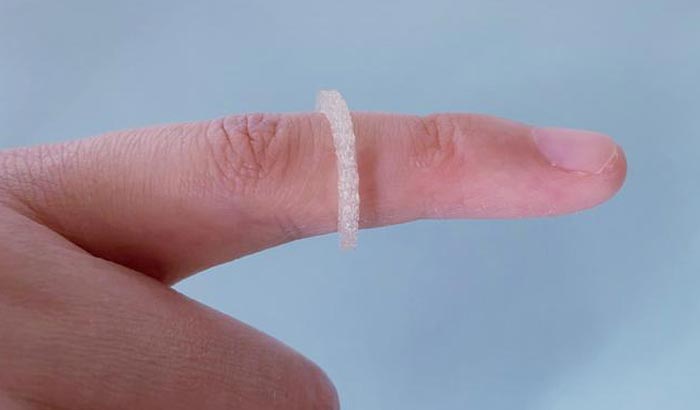Scientists develop a new kind of printable, wearable insect repellent

This is what the ring looks like that could help repel insects.
Credit: Uni Halle / Fanfan Du
A new type of insect-repellent delivery device has been developed by scientists from the Martin Luther University Halle-Wittenberg (MLU).
With the help of a 3D printer, the active ingredient is first “encapsulated” and formed into the desired shape, such as a ring, which can then be worn and releases an agent designed to repel mosquitoes for a long time. The team has presented its work in the “International Journal of Pharmaceutics”.
The researchers have developed their prototypes using “IR3535”, an insect repellent developed by MERCK. “Mosquito sprays containing IR3535 are very gentle on the skin and have been used all over the world for many years. That’s why we’ve been using the agent for our experiments”, says Professor René Androsch from the MLU. It is usually applied as a spray or lotion and offers several hours of protection. However, Androsch and his team are looking for ways to release the agent over a much longer period, such as by encapsulating it in a wearable ring or bracelet.
The researchers have succeeded in using a special 3D printing technique to insert the insect repellent into a biodegradable polymer in a controlled manner and to shape the mixture of substances in various ways. “The basic idea is that the insect repellent continuously evaporates and forms a barrier for insects”, explains the lead author of the study, Fanfan Du, a doctoral candidate at the MLU. The rate at which the insect repellent evaporates depends on many different factors, including temperature, concentration and the structure of the polymer used. After conducting various experiments and simulations, the team predicts that the insect repellent needs well over a week to evaporate completely at a temperature of 37°C (98,6 °F, i.e., body temperature).
While the researchers have proven that it is absolutely possible to develop a wearable insect repellent, the rings and other forms created for the study are only prototypes. According to Androsch, further research needs to be carried out to determine how well the rings function under actual conditions. The encapsulation material could also be further optimised.
The work was funded by the Deutsche Forschungsgemeinschaft (DFG, German Research Foundation) and within the framework of the graduate school “AGRIPOLY” at MLU. “AGRIPOLY” is funded by the European Social Fund (ESF) and the state of Saxony-Anhalt.
Originalpublikation:
Study: Du F., et al. 3D-printing of the polymer/insect-repellent system poly(l-lactic acid)/ethyl butylacetylaminopropionate (PLLA/IR3535). International Journal of Pharmaceutics (2022). doi: 10.1016/j.ijpharm.2022.122023
https://doi.org/10.1016/j.ijpharm.2022.122023
Media Contact
All latest news from the category: Materials Sciences
Materials management deals with the research, development, manufacturing and processing of raw and industrial materials. Key aspects here are biological and medical issues, which play an increasingly important role in this field.
innovations-report offers in-depth articles related to the development and application of materials and the structure and properties of new materials.
Newest articles

First-of-its-kind study uses remote sensing to monitor plastic debris in rivers and lakes
Remote sensing creates a cost-effective solution to monitoring plastic pollution. A first-of-its-kind study from researchers at the University of Minnesota Twin Cities shows how remote sensing can help monitor and…

Laser-based artificial neuron mimics nerve cell functions at lightning speed
With a processing speed a billion times faster than nature, chip-based laser neuron could help advance AI tasks such as pattern recognition and sequence prediction. Researchers have developed a laser-based…

Optimising the processing of plastic waste
Just one look in the yellow bin reveals a colourful jumble of different types of plastic. However, the purer and more uniform plastic waste is, the easier it is to…



